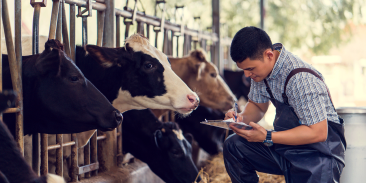Rice nitrous oxide: A new solvable climate problem
Certain farming techniques can help mitigate net climate impact of rice
Read our full-length response to the International Rice Research Institute’s commentary on this study’s findings.
Rice is a critical source of nutrition for the world’s rapidly growing population, providing more calories to humans than any other grain. However, rice farming is resource-intensive: rice cultivation covers 11% of the earth’s arable land, consumes one-third of irrigation water and emits large quantities of methane and nitrous oxide into the atmosphere.
Both methane and nitrous oxide are powerful greenhouse gases, though nitrous oxide has a higher climate impact than methane over long time periods. Yet the agricultural climate mitigation community has focused on methane as the primary climate-polluter emitted from rice farms. This is because of the assumption that most rice farms across the world experience continuous flooding, which tends to emit high levels of methane but very small amounts of nitrous oxide emissions.
The go-to method to address this problem of methane emissions is intermittent flooding. However, new research published in Proceedings of the National Academy of Sciences shows that intermittently flooded rice farms can emit up to 45 times higher nitrous oxide as compared to the maximum from continuously flooded farms that predominantly emit methane.
Global insights
We have also published an accompanying global analysis showing that under intensified use of intermittent flooding, nitrous oxide emissions from rice farms across the world might be 1.5 to 2.4 million tons, which is 25 to 40 times higher than previous estimates that assumed continuous flooding at most rice farms.
Mitigation potential
Our research shows that shallow (mild-intermittent) flooding along with co-managing fertilizer and organic matter can reduce the net climate impact of rice cultivation at individual farms by up to 90% over a 100 year period. The global mitigation potential due to improved rice management practices is twice the current estimate of 250 million tons CO2e100 years and it is crucial to discuss these results in the upcoming UNFCCC discussions on water and nutrient management.
Risk maps
We present our global assessment of risk of high nitrous oxide emissions under a medium-intermittent flooding scenario in these maps.
Recommendations
EDF and its research partners are calling upon farmers, scientists and policymakers across the world to pay attention to nitrous oxide emissions from rice farms. Going forward, we recommend:
- Mapping the actual flooding regimes at farmer-managed irrigated farms across the world.
- Measuring and reporting both nitrous oxide and methane emissions from rice farms through high-intensity sampling, especially from major rice producing countries.
These two steps will help in assessing the relative importance of nitrous oxide vs methane emissions from rice farms in multiple geographies. They will also help in calibrating water, fertilizer and organic manure use in region-specific ways. This allows farmers to minimize nitrous oxide and methane emissions, while increasing rice yields and farm incomes.
Efforts from international organizations to reduce methane by promoting alternate wetting and drying have mobilized governments as well as public and private investments. They have helped build the bottom-up institutional capacity that is crucial for operationalizing agricultural climate mitigation practices. Given that water management is central to reducing nitrous oxide emissions as well as methane, these organizations are also best situated to translate our latest findings into meaningful action.
MEDIA CONTACT
Raul Arce Contreras
(240) 480-1545 (mobile)










